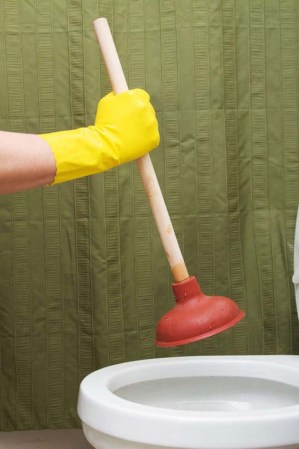How to Employ Plungers and Drain Cleaner Successfully: Expert Advice
How to Employ Plungers and Drain Cleaner Successfully: Expert Advice
Blog Article
Here underneath yow will discover additional brilliant facts in relation to Tips on How to Effectively Use a Plunger.

Introduction
Appropriate upkeep of home drains pipes is essential for stopping obstructions and guaranteeing smooth water circulation. Among the key tools in every house owner's toolkit is the bettor, along with various drain cleaners created to deal with persistent obstructions properly. This article explores how to utilize plungers and drain cleaners effectively to keep your drains pipes flowing freely.
Section 1: Comprehending Bettors
Sorts of Plungers
There are numerous types of plungers available, each designed for different sorts of drains pipes and obstructs. The most typical types include cup plungers, flange plungers, and accordion plungers.
Just How Plungers Work
Plungers deal with the concept of creating pressure and suction to remove blockages. When properly used over a drain, they develop a vacuum that can take out debris or break up clogs.
Choosing the Right Bettor
Selecting the best bettor depends on the kind of drainpipe and the nature of the blockage. Mug bettors are excellent for sinks and bathtubs, while flange bettors are much better fit for toilets due to their style.
Typical Blunders with Bettors
Avoiding these mistakes guarantees efficient plunging: inappropriate seal around the drain, inadequate pressure, and not clearing bordering particles.
Section 2: Using Plungers Properly
Preparation
Prior to diving, guarantee the plunger covers the drainpipe totally and creates a tight seal. Clear any kind of visible debris around the drain opening.
Strategy
Beginning with mild diving activities to build suction. Rise stress slowly, making use of a constant rhythm. Repeat as necessary until the drainpipe clears.
Troubleshooting Tips
If plunging does not work, attempt changing the seal, applying petroleum jelly for a far better seal, or using a different kind of plunger.
Section 3: Comprehending Drainpipe Cleaning Company
Types of Drain Cleaners
Drain cleaners can be chemical or chemical. Chemical cleansers utilize solid chemicals to liquify clogs, while enzymatic cleansers utilize natural enzymes to break down organic matter.
How Drain Cleaning Company Job
Chemical cleansers react with clogs to liquify them, while chemical cleaners break down organic products like hair and grease without harming pipelines.
Security Considerations
Constantly use gloves and eye defense when utilizing chemical drain cleansers. Make sure sufficient air flow and comply with manufacturer guidelines thoroughly.
Eco-Friendly Alternatives
Consider utilizing vinegar and baking soft drink or enzyme-based cleaners for green options that are more secure for pipes and the atmosphere.
Area 4: Using Drain Cleaning Company Effectively
Application Methods
Put chemical cleansers directly into the drain opening. Allow them to help the recommended time prior to flushing with warm water. Chemical cleansers should sit over night.
Preventative measures
Prevent mixing different types of cleansers, as this can produce hazardous fumes. Never ever make use of chemical cleansers in conjunction with a bettor, as spilling can happen.
Dealing With Stubborn Clogs
For consistent blockages, consider making use of a pipes serpent or calling a professional plumbing professional to avoid damage to pipes.
Verdict
In conclusion, understanding just how to utilize plungers and drainpipe cleaners properly is vital for maintaining healthy and balanced pipes systems. By choosing the right tools and methods, home owners can take on minor blockages and stop significant plumbing problems down the line.
How To Properly Use A Plumbing Snake To Clear Drains
When any drain clogs in our home arise, we tend to gravitate toward the plunger and little else. In cases where the plunger and its vacuum-created pressure are not able to clear clogs, many immediately move to harmful chemicals or simply call their plumber to fix the issue.
we’re happy to help with all drain cleaning needs and concerns. This includes informing you on a few other home remedies you may have at your disposal for minor to moderate clogs, one of which is the use of a plumbing snake. Many people have never used one of these before – let’s go over the steps to take when your drain clogs and you have a plumbing snake available.
Attempt Plunger Use
The first step here, as we noted above, should indeed be to grab your plunger when you notice a drain clog and attempt to resolve it this way. If you’re unsure how to use a particular type of plunger, our plumbers can answer any questions you have. If this doesn’t do the trick, however, you move on to the snake.
Locate And Prepare Snake
A plumbing snake is a metal or plastic device that’s generally about a quarter of an inch thick. It’s design with significant extensions, meant to reach down into your clogged drain and push the clog out. Snakes also contain drain augers that will latch onto and push stubborn blockages.
If your plunger doesn’t clear a clog, locate your snake and bring it to the drain in question. We also recommend keeping a bucket nearby to collect the clog once you pull it out, plus we’d advise wearing goggles and possibly protective gloves.
Feed Snake
Once you’re ready to go, feed the snake slowly down the drain, using the crank device it comes with to keep it moving until it finds the clog. Once this happens, much of the clog will be latched onto the coil so you can pull it out, while the rest will simply break up and flow downward.
Detach Debris
Remove the snake slowly from the drain, and once you’ve done so, pick off any debris that’s stuck to the coil. This is another area where wearing gloves is a must.
Flush Drain
Finally, take a few minutes to ensure the snake has done its job correctly. If you’ve been using it on a toilet, flush the toilet a couple times and make sure everything flows well. If you’ve used it on a different drain, flush it with some room temperature water.
https://www.mybuddytheplumber.com/blog/how-to-properly-use-a-plumbing-snake-to-clear-drains/

Application Methods
Put chemical cleansers directly into the drain opening. Allow them to help the recommended time prior to flushing with warm water. Chemical cleansers should sit over night.
Preventative measures
Prevent mixing different types of cleansers, as this can produce hazardous fumes. Never ever make use of chemical cleansers in conjunction with a bettor, as spilling can happen.
Dealing With Stubborn Clogs
For consistent blockages, consider making use of a pipes serpent or calling a professional plumbing professional to avoid damage to pipes.
Verdict
In conclusion, understanding just how to utilize plungers and drainpipe cleaners properly is vital for maintaining healthy and balanced pipes systems. By choosing the right tools and methods, home owners can take on minor blockages and stop significant plumbing problems down the line.
How To Properly Use A Plumbing Snake To Clear Drains
When any drain clogs in our home arise, we tend to gravitate toward the plunger and little else. In cases where the plunger and its vacuum-created pressure are not able to clear clogs, many immediately move to harmful chemicals or simply call their plumber to fix the issue.
we’re happy to help with all drain cleaning needs and concerns. This includes informing you on a few other home remedies you may have at your disposal for minor to moderate clogs, one of which is the use of a plumbing snake. Many people have never used one of these before – let’s go over the steps to take when your drain clogs and you have a plumbing snake available.
Attempt Plunger Use
The first step here, as we noted above, should indeed be to grab your plunger when you notice a drain clog and attempt to resolve it this way. If you’re unsure how to use a particular type of plunger, our plumbers can answer any questions you have. If this doesn’t do the trick, however, you move on to the snake.
Locate And Prepare Snake
A plumbing snake is a metal or plastic device that’s generally about a quarter of an inch thick. It’s design with significant extensions, meant to reach down into your clogged drain and push the clog out. Snakes also contain drain augers that will latch onto and push stubborn blockages.
If your plunger doesn’t clear a clog, locate your snake and bring it to the drain in question. We also recommend keeping a bucket nearby to collect the clog once you pull it out, plus we’d advise wearing goggles and possibly protective gloves.
Feed Snake
Once you’re ready to go, feed the snake slowly down the drain, using the crank device it comes with to keep it moving until it finds the clog. Once this happens, much of the clog will be latched onto the coil so you can pull it out, while the rest will simply break up and flow downward.
Detach Debris
Remove the snake slowly from the drain, and once you’ve done so, pick off any debris that’s stuck to the coil. This is another area where wearing gloves is a must.
Flush Drain
Finally, take a few minutes to ensure the snake has done its job correctly. If you’ve been using it on a toilet, flush the toilet a couple times and make sure everything flows well. If you’ve used it on a different drain, flush it with some room temperature water.
https://www.mybuddytheplumber.com/blog/how-to-properly-use-a-plumbing-snake-to-clear-drains/

Do you enjoy more info about A Guide to Plungers (and How to Use Them)? Put a review below. We would be pleased to see your reactions about this write up. Hoping to see you back again before long. For those who liked our post if you please make sure you remember to pass it around. Thanks a bunch for your time. Come back soon.
Book Today Report this page